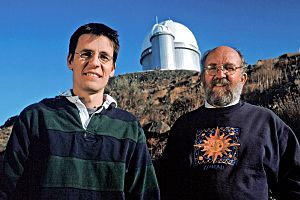Michel Mayor facts for kids
Quick facts for kids
Michel Mayor
|
|
|---|---|

Mayor in 2012
|
|
| Born |
Michel Gustave Édouard Mayor
12 January 1942 Lausanne, Switzerland
|
| Education | University of Lausanne (MS) University of Geneva (PhD) |
| Known for | Discovered first planet orbiting around a normal star, 51 Pegasi |
| Awards | Prix Jules Janssen (1998) Albert Einstein Medal(2004) Shaw Prize (2005) Kyoto Prize in Basic Sciences (2015) Wolf Prize (2017) Nobel Prize in Physics (2019) |
| Scientific career | |
| Fields | Astrophysics |
| Institutions | University of Geneva |
| Thesis | "The kinematical properties of stars in the solar vicinity: possible relation with the galactic spiral structure" (1971) |
| Doctoral students | Didier Queloz |
Michel Mayor (born January 12, 1942) is a famous Swiss astrophysicist. An astrophysicist is a scientist who studies stars, planets, and space. He is a professor at the University of Geneva's Department of Astronomy. Even though he officially retired in 2007, he continues his research at the Observatory of Geneva.
In 1995, Mayor and his colleague Didier Queloz made a groundbreaking discovery. They found the first extrasolar planet, or exoplanet, orbiting a star similar to our Sun. This planet is called 51 Pegasi b. An exoplanet is any planet outside of our Solar System.
Because of this amazing achievement, Mayor and Queloz won the 2019 Nobel Prize in Physics. The prize recognized their work for helping us better understand the universe and our planet's place in it.
Mayor has said that humans will probably never travel to these distant exoplanets. He explained they are "much, much too far away." With today's technology, a trip would take hundreds of millions of days! However, his discoveries have made the search for alien life seem more possible than ever before.
Contents
Education and Career
Michel Mayor earned a degree in Physics from the University of Lausanne in 1966. He then went on to get his PhD in Astronomy from the Geneva Observatory in 1971.
After finishing his studies, he worked as a researcher at the University of Cambridge in England. He also spent time at the European Southern Observatory (ESO) in Chile and the Institute for Astronomy in Hawaii, using their powerful telescopes.
From 1971, Mayor worked at the Observatory of Geneva. He became a professor at the University of Geneva in 1988. He was also the director of the observatory from 1998 to 2004.
Planet-Hunting Research
Mayor's main research interest is finding exoplanets. He also studies star clusters and the structure of our galaxy. To find planets so far away, he needed special tools.
Developing New Tools
In the 1970s, Mayor helped develop a special instrument called CORAVEL. This tool could measure a star's radial velocity very accurately. Radial velocity is the tiny "wobble" a star makes when a planet's gravity pulls on it as it orbits. By measuring this wobble, astronomers can tell if a planet is there.
Later, Mayor and his student Didier Queloz helped create an even more powerful tool called the ELODIE. It was designed to hunt for giant planets or brown dwarfs (objects bigger than a planet but smaller than a star).
The First Big Discovery
In 1994, Mayor and Queloz began using ELODIE to study stars that looked like our Sun. In July 1995, they confirmed that a planet was orbiting the star 51 Pegasi. This planet, 51 Pegasi b, was the first exoplanet ever found orbiting a normal, Sun-like star. It is a type of planet called a hot Jupiter because it is a gas giant that orbits very close to its star.
This discovery was a huge moment in astronomy. It sparked a worldwide race to find more exoplanets. As of March 2022, astronomers have confirmed the existence of over 5,000 exoplanets.
Finding More Worlds
Mayor continued to improve the technology for finding planets. He led a team that built the High Accuracy Radial Velocity Planet Searcher (HARPS). This instrument was installed at the La Silla Observatory in Chile and could detect even smaller wobbles.
Using HARPS, Mayor and his team made more incredible discoveries:
- In 2007, they found Gliese 581c. This was the first exoplanet discovered in its star's "habitable zone." The habitable zone is the area around a star where the temperature is just right for liquid water to exist.
- In 2009, they found Gliese 581e. At the time, it was the lightest exoplanet ever found orbiting a normal star.
Awards and Honors
Michel Mayor has received many awards for his important work. Here are some of the most famous ones:
- Prix Jules Janssen (1998)
- Albert Einstein Medal (2004)
- Shaw Prize in Astronomy (2005)
- Wolf Prize in Physics (2017)
- Nobel Prize in Physics (2019)
In 2001, an asteroid was named 125076 Michelmayor in his honor. It was discovered by the Swiss astronomer Michel Ory. Mayor has also received honorary degrees from eight universities around the world.
See also
 In Spanish: Michel Mayor para niños
In Spanish: Michel Mayor para niños


